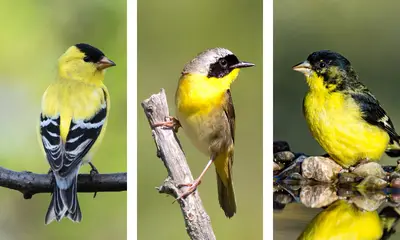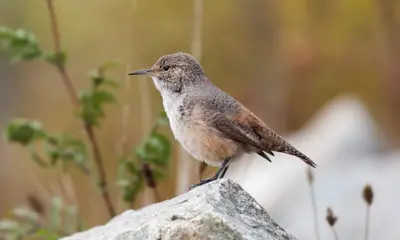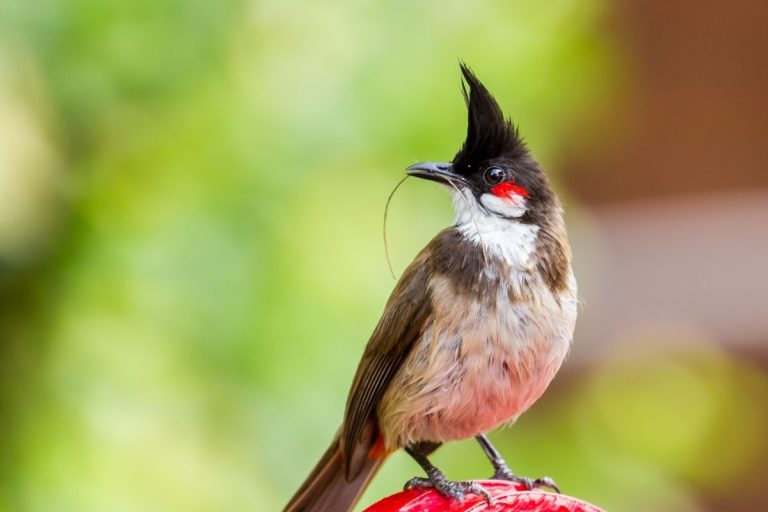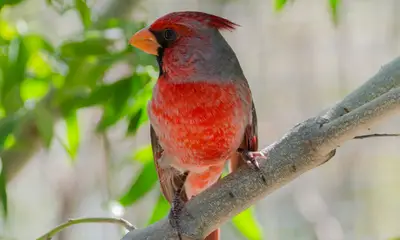15 Types Of BLACK Birds In Florida (ID Guide With Photos)
Did you recently come across a black bird in Florida, and want to know what species it was?
Identifying black-colored birds in Florida is not as easy as it might seem, since there are many bird species in the sunshine state that are either completely black or partially black.
To help you identify the bird you saw, we’ll cover all the different species of black-colored birds that can be seen in Florida.

What types of black birds are found in Florida?
The 15 types of black-colored birds found in Florida are:
- Common Grackle
- Boat-tailed Grackle
- Red-winged Blackbird
- American Crow
- Anhinga
- American Coot
- Smooth-billed Ani
- Rusty Blackbird
- White-crowned Pigeon
- Brewer’s Blackbird
- Brown-headed Cowbird
- Orchard Oriole
- Common Starling
- Snail Kite
While many of these birds are year round residents of Florida, others only occur in the state during the nesting season in summer.
Yet other species are winter visitors in Florida, and some are vagrants that only rarely occur in the state.
Now let’s dive into the details, and take a closer look at each of these black-colored species in order to get the full scoop:
Common Grackle
Scientific name: Quiscalus quiscula
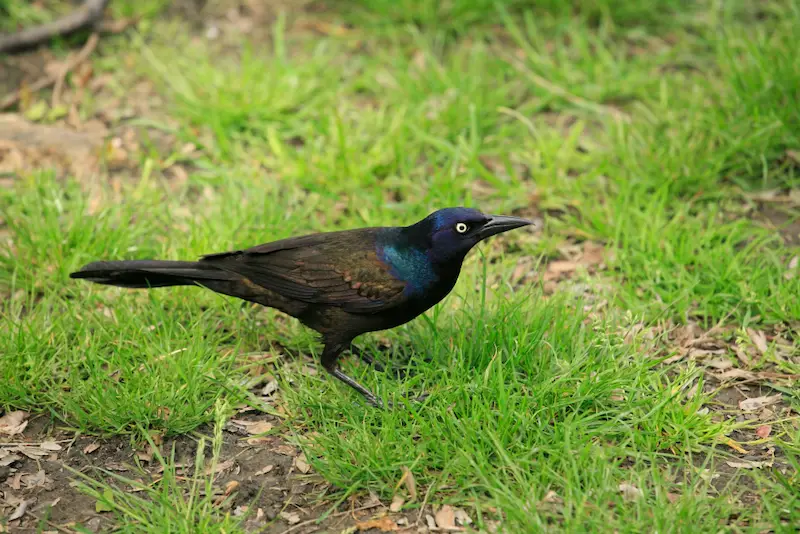
From a distance, a Common grackle seems to be an entirely black-colored bird, making it easy to confuse it with a crow, which is also entirely black.
But in contrast to a crow, the Common Grackle has a pointed beak that is formed like a cone, as well as eyes that are bright yellow, and a long tail that is shaped like a wedge.
In Florida, it lives in open spaces such as meadows, parks, and fields, as well as suburban and residential regions
Male Common Grackles have shimmering purple coloration on the black feathers of their heads, breasts, and necks, as well as other parts of their bodies.
During the nesting season, the females construct large nests in which they will lay a clutch of about five eggs.
In northern parts of its range, the Common Grackle is a migratory summer visitor, but in Florida it can be found year round.
It is a member of the New World family of blackbirds, which contains some of the most common birds in North America, many of which like to gather in large flocks and make a lot of noise.
On farms, Common Grackles can congregate in huge flocks to feed on crops and grain, and to roost, which can cause a problem to Florida farmers.
Because it is such a versatile species, the Common Grackle can thrive in many different environments.
Boat-tailed Grackle
Scientific name: Quiscalus major
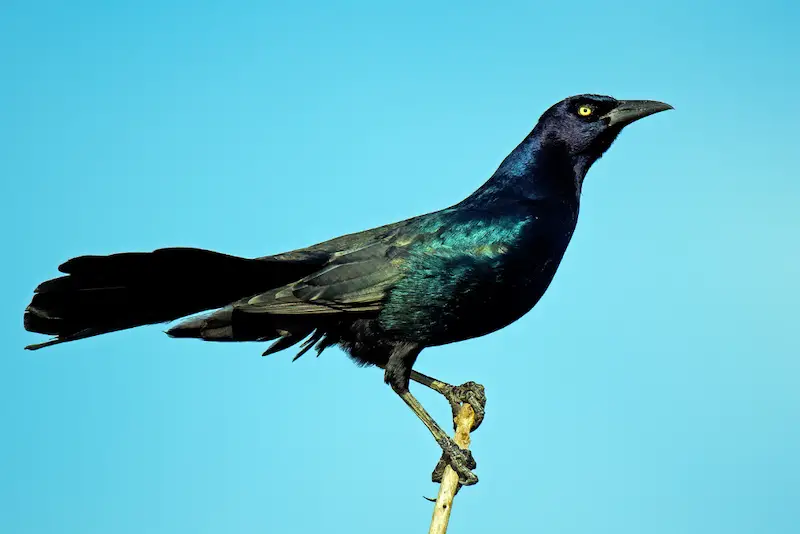
Bigger than the Common Grackle, the Boat-tailed Grackle is best identified by its long tail that has a broad end resembling a spatula.
Similar to other grackles, the tail is often folded in the shape of a keel, with the tail margins held higher than the center.
Adult male Boat-tailed Grackles are entirely glossy black with a metallic sheen that’s strongest on the head and back.
This bird is a year-round resident in Florida that is most often found in marshy habitats, as well as urban parks.
Anhinga
Scientific name: Anhinga anhinga
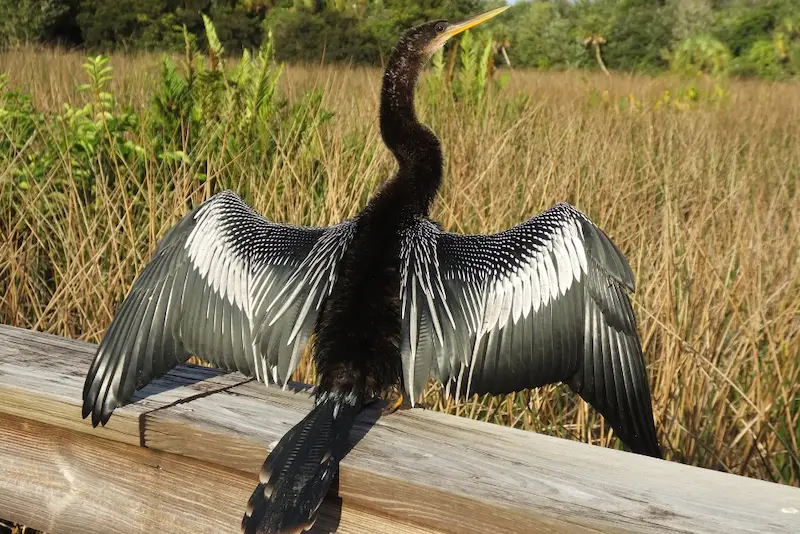
The Anhinga looks similar to a cormorant, but has a snake-like neck, which it uses to catch fish underwater.
When it is in the water, it’s common to see only the head and neck protruding above the water surface.
Adult male Anhingas are almost entirely black, while females have a dark brown head and neck, as well as black body plumage.
It lives in swamps and freshwater ponds, and is a year-round resident in Florida.
Rusty Blackbird
Scientific name: Euphagus carolinus
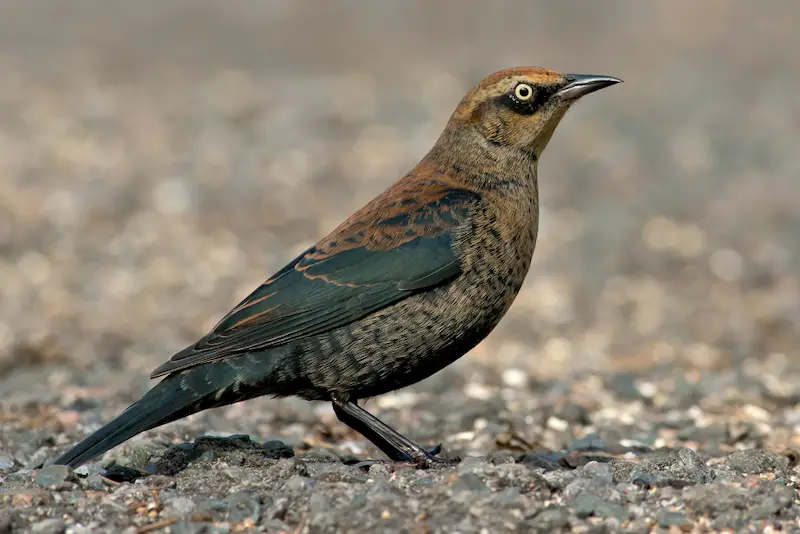
The Rusty Blackbird is substantially less of a problem to agricultural activities than some of the other members of its family.
The reason for this is that it breeds in regions that are remote and are located in marshy, non-cultivated areas.
Adult male Rusty Blackbirds are uniformly black, while females and juveniles are brownish gray with some black feathers.
During the autumn months, the plumage of the male transforms into a drab, rusty brown color.
During the fall migration it is easiest to spot this bird in Florida. This is because it travels south from its main breeding grounds in Canada, and passes through Florida in large flocks at this time.
While many of these birds pass through Florida on their fall and spring migrations, some spend the whole winter, and can be seen in Florida from September through late April.
The preferred habitat of these birds is swampland, marshy areas, and the banks of lakes and rivers.
Unfortunately, there has been a dramatic decline in the population of this species, and it is now on the red list of the IUCN.
Smooth-billed Ani
Scientific name: Crotophaga ani
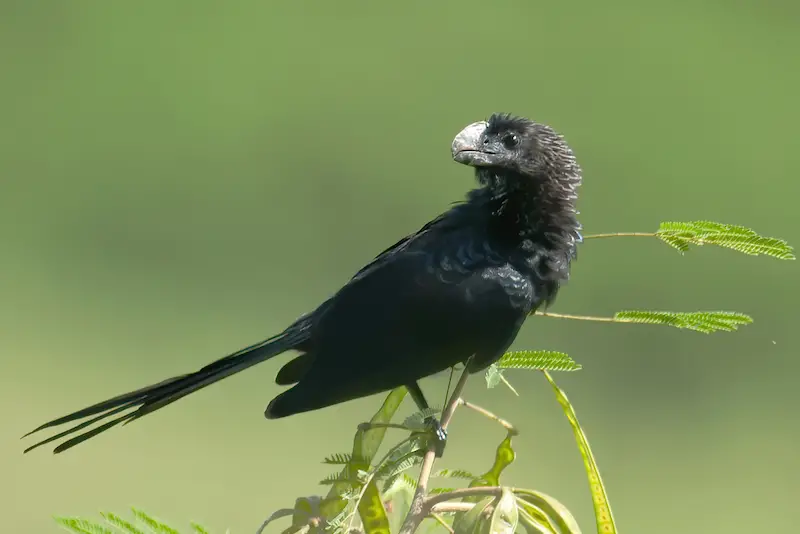
A rare bird in open grassland and urban fields, the Smooth-billed Ani is entirely black, with tinges of greenish blue on its back.
A great identifying characteristic of the Smooth-billed Ani is its large beak that has a keel shaped protrusion on the top.
It is a year-round breeding bird in the state of Florida, and predominantly feeds on small animals and fruits.
White-crowned Pigeon
Scientific name: Patagioenas leucocephala
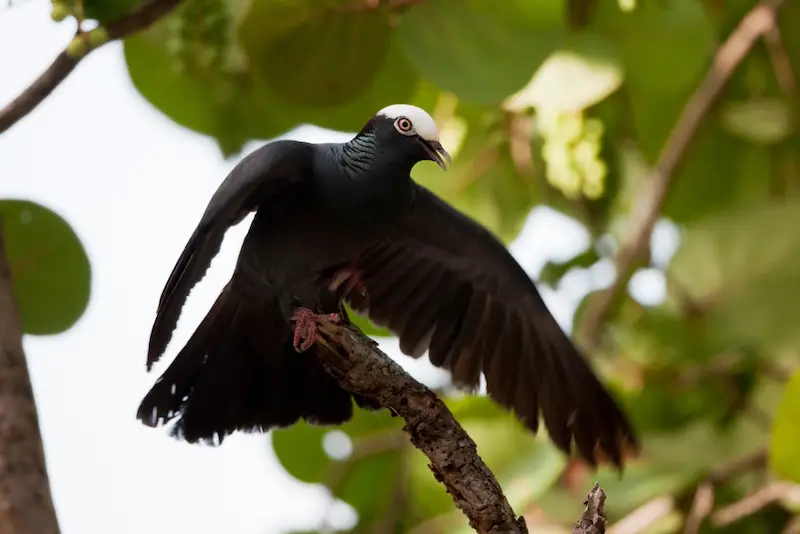
This pigeon is most commonly found in the Caribbean, and is a rare breeding bird in southern Florida.
The White-crowned Pigeon is almost entirely blackish gray, except for a bright white crown in adult birds, that extends down to the level of the dark eye.
Similar to many other pigeon and dove species, it has stripes of iridescent black feathers on its nape. It is a secretive bird that lives in mangrove forests and coastal woodlands.
Common Starling
Scientific name: Sturnus vulgaris
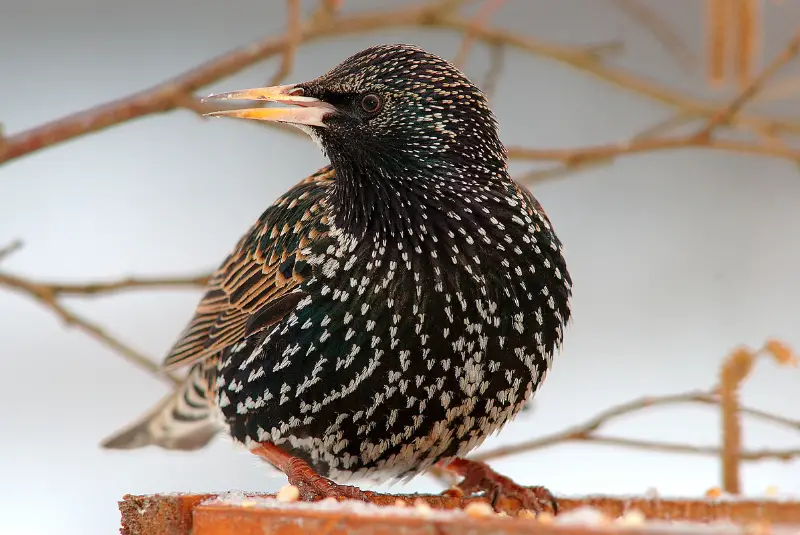
The Common Starling (also known as European Starling) is a common and highly successful bird in Florida. Adult Common Starlings are uniformly black with a glossy sheen.
During winter, Common Starlings are black, but covered with light spots, which can be a great characteristic to identify them.
This black species is originally from Europe, Asia, and North Africa, but it was introduced to North America and many other parts of the world, where it has established itself as a successful breeding species within a short period of time.
Common Starlings inhabit open country with few trees as their original habitat, but they are also among the most successful urban birds, and are especially common in parks and gardens.
While Common Starlings nest in tree holes in the wild, they are also known to nest inside buildings and nest boxes in urban settings.
Unfortunately, native birds are sometimes driven out of their nesting sites by competing Starlings.
Similar to grackles and other blackbirds, Common Starlings form large flocks outside of the nesting season.
These flocks can contain more than a million birds, and can be seen performing amazing aerial acrobatics.
Brewer’s Blackbird
Scientific name: Euphagus cyanocephalus
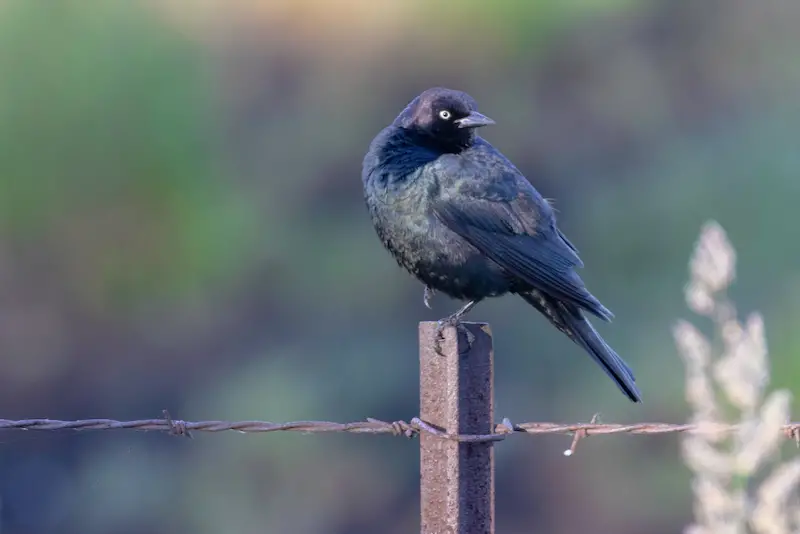
In a large portion of its range, the Brewer’s Blackbird appears to choose environments that have been shaped by humans, rather than natural ones.
However, in areas where this bird competes with the Common Grackle, it instead prefers more rural areas.
Similar to other species in its family, Brewer’s Blackbirds like to congregate in large flocks in autumn, and feed on leftover grains found on farmland after the harvest.
This bird is about the size of a robin and has long legs and a long black tail. When birds are seated on the ground or perched on a branch, their tails give the appearance of being broadened and rounded.
Adult males are completely black with a purple sheen on the black feathers of their head, which fades into a greenish hue on the rest of their body.
In contrast to this, females and juveniles of this species are a more uniform brown color, with their wings and tails being grayish black.
You can find this bird in open habitats, such as grasslands and meadows, but also more urban areas, such as parks and lawns.
Of all the species of blackbirds in Florida, the Brewer’s Blackbird is relatively rare, and is mostly observed as a rare migrant that can be seen during spring and fall.
Brown-headed Cowbird
Scientific name: Molothrus ater
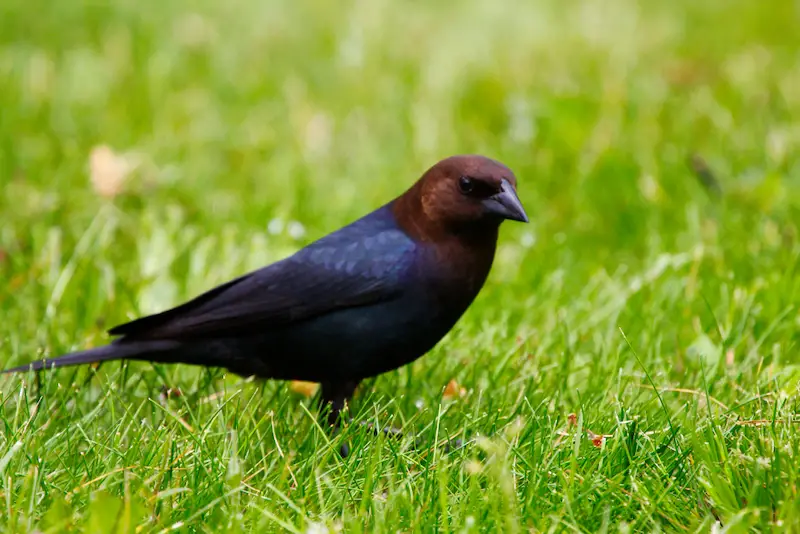
Cowbirds also belong to the blackbird family, but differ in one key characteristic: they are brood parasites.
The Brown-headed Cowbird is the only brood parasite in Florida. A brood parasite is a bird that doesn’t build its own nest, but instead lays its eggs in the nests of other birds.
Brown-headed Cowbirds have been reported to lay their eggs in the nests of hundreds of other bird species.
Only a few of the host birds targeted by Cowbirds identify the parasitic eggs as alien, and abandon them. Most hosts incubate the Cowbird eggs and raise the resulting nestlings as if they were their own.
If you see a warbler or other small bird in Florida feeding a young bird twice its size, you can be sure that it’s raising a Cowbird.
Adult male Brown-headed Cowbirds have a chocolate-brown head and an iridescent black body. Females, on the other hand, are dull gray-brown with shades of black.
Cowbirds got their name because they like to follow buffaloes and cattle around in order to eat insects and other small animals that are disturbed by the large animals.
This bird can be seen in Florida year-round, though it tends to move around a lot in the non-breeding season searching for food.
Brown-headed Cowbirds typically forage for food on the ground in flocks that also contain other types of blackbirds and starlings.
Orchard Oriole
Scientific name: Icterus spurius
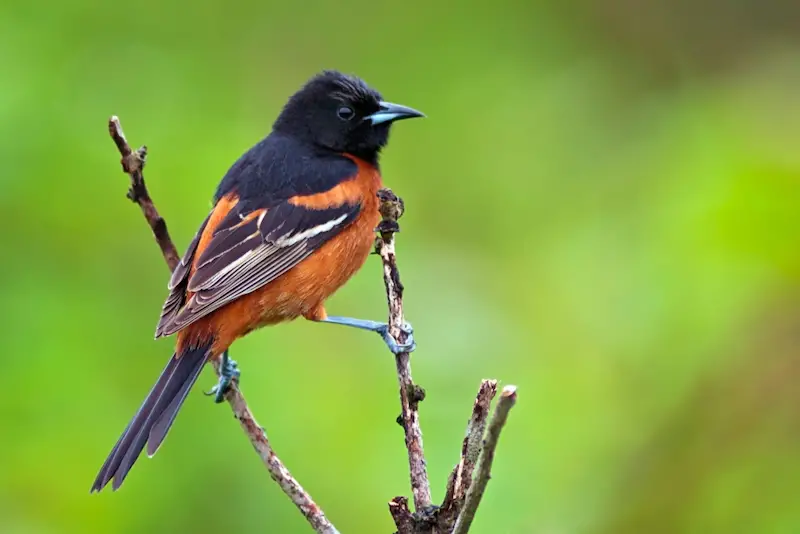
This Oriole got its name from its preference for orchards and open woods. It is a summer visitor in Florida, and is most commonly found in the southern part of the state.
Unlike the females (which are mostly dull yellow with black wing tips), males are a dark orange color with a black head, as well as a black throat, upper back, wings, and tail.
Young males resemble females in color, and gradually become more and more black over their first two years.
Early in the summer, the Orchard Oriole feeds on insects, but later it will switch to eating wild fruit as they become mature.
After their young have fledged, parent Orioles will bring them to feeding stations (especially if you have a nectar feeder.
Some people mistakenly believe that the Orioles have departed since they do not see them at their feeders very often during the peak of the summer.
However, the birds are still present nearby, but are simply focused on catching insects to bring back to their nestlings.
The Orchard Oriole is one of the birds that gets here very late in the spring and is one of the ones that leaves quite early in the fall.
American Coot
Scientific name: Fulica americana
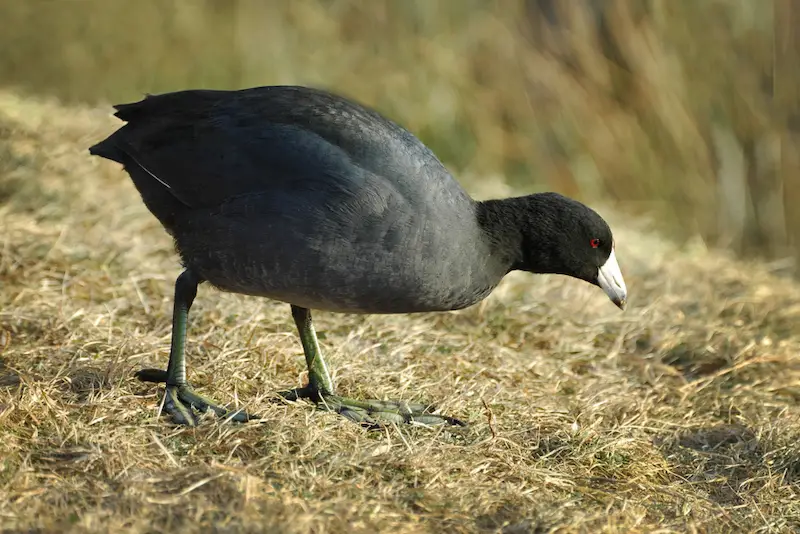
American Coots are regularly observed congregating in huge flocks on open water (especially during migration).
Coots range in color from dark gray to black and have a white beak and forehead, as well as a red eye.
While American Coots are water birds, they don’t have webbed feet like ducks, but instead have broad, lobed toes.
In addition to their ability to swim on top of the water, Coots are also strong diving birds, and often forage for food on the bottom of shallow lakes and ponds.
Bald Eagles like to prey on Coots, and will try to tire out an individual by repeatedly forcing it to dive until it is too exhausted and gives up
American Coots may be found in a variety of aquatic habitats, including urban park ponds, reservoirs, marshes, and lake shores.
Its nest is a floating platform that is anchored to the surrounding plants.
This bird breeds in northern Florida, and is only found in southern Florida during migration in spring and fall.
American Crow
Scientific name: Corvus brachyrhynchos
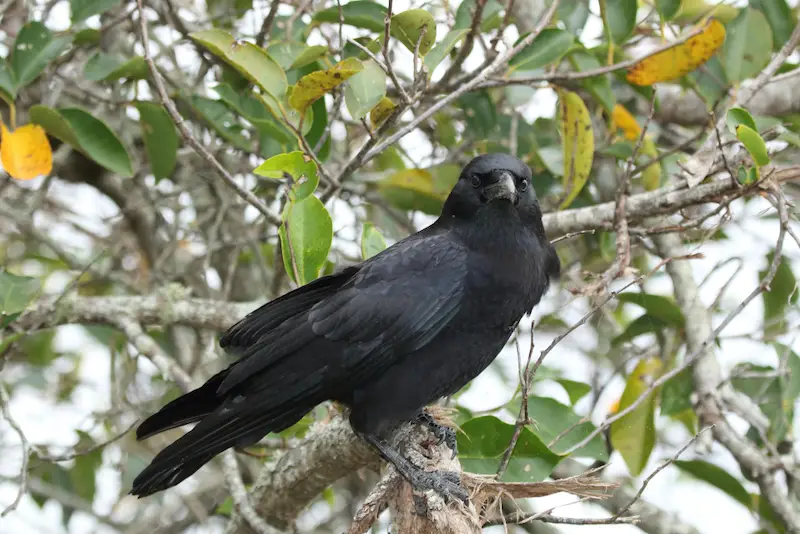
This is one of the most easily recognized black-colored birds in Florida.
American Crows are large birds that are entirely black, including black beaks, legs, and eyes. Both adults and immature birds are completely black, and hard to distinguish from each other .
This is one of the most intelligent birds in the world. It also happens to be one of the most sociable, and it likes to pass the time by harassing other birds.
Similar to vultures and other birds of prey in Florida, American Crows like to feed on roadkill, but rarely get hit by cars themselves.
The American Crow builds a big stick nest in trees, which it likes to reuse for many years. Old crows nests are also used by many other birds, including raptors and owls.
Family groups of crows sleep together at night but split off during the day to go foraging.
Outside of the breeding season, it forms massive flocks, sometimes topping out at thousands of birds.
American Crows are common in Florida in open forests and woodlands, as well as farmland and urban areas such as parks, golf courses, and large gardens.
Snail Kite
Scientific name: Rostrhamus sociabilis

The Snail Kite specializes in feeding on one particular kind of snail that is found in freshwater marshes.
After it snatches a snail from the aquatic vegetation in a shallow marsh, it uses its thin, hooked bill to remove the meat of the snail from its shell.
Male Snail Kites are a dark shade of grayish black, except for the tail, which is white at the front end, and black at the rear margin.
A tropical kite species, the Snail Kite only breeds in Florida, but no other US state. It is most commonly found in the Everglades.
What are the most common black birds in Florida?
The most common black birds in the sunshine state are Common Grackles. They are regular breeding birds all over Florida, and frequent guests at bird feeders.
Outside of the breeding season, these black passerines form large flocks that can number thousands of birds, feeding on leftover grains on harvested fields.
Are there ravens in Florida?
There are no wild ravens in Florida – the breeding range of the Common Raven is restricted to the western part of the USA (with the closest breeding population found in western Texas).
On rare occasions, it’s possible to see a vagrant raven in Florida, or an escaped individual from a local bird park.
However, if you see a large bird that looks like a raven, you might very well be looking at an American Crow, which is also black, and looks very similar to the Common Raven (albeit smaller).


